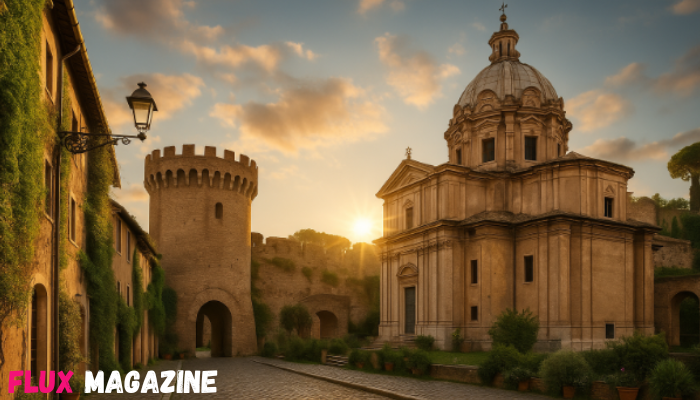Below the splendor of the Colosseum and the throngs of the Vatican, there exists a Rome many travelers will never find. These hidden gems in Rome are where the city’s spirit comes alive, hidden in cobbled streets, behind unknown doors, and outside of where a typical tourist map leads. Finding these destinations requires giving up your place in queues, your knowledgeable tour guides, or your postcards, and instead allow the quiet moments of discovery to turn into memories.
This guide will reveal lesser-known locations that display the authentic charm of Rome, peaceful gardens, deceptive art, neglected villas, or genuine neighborhoods that have yet to be tarnished by the mass tourist experience. Each location shares a story, scene, or scent that gives avid travelers a reason that museums, writers, and dreamers have always gravitated towards this city for centuries.
Suppose you want to explore Rome instead of looking at it. In that case, there are resources available, such as https://rollingrome.com, to plan itineraries tailored and built by a mix of popular and non-touristic sights, designed for a true Roman adventure.
Why Seek Out Lesser-Known Corners of Rome?
Exploring Rome’s hidden corners transforms sightseeing into a soulful experience. These places aren’t just quiet alternatives to the city’s iconic visitor sites, they are the very essence that makes Rome itself, where daily life intersects with layers of history.
Choosing the road less traveled allows you to:
- Experience authenticity – Meet locals, not just fellow tourists.
- Avoid crowds – Enjoy serenity in a city that rarely sleeps.
- Save time and money – Many hidden gems are free or inexpensive.
- Deepen your connection – Learn Rome’s history through subtle details, not museum walls.
| Mainstream Rome | Hidden Rome |
| Long queues at the Colosseum | Peaceful walks beneath ancient aqueducts |
| Tour groups at the Vatican | Private frescoes inside a Renaissance villa |
| Selfie sticks in Trevi Fountain | Sunset views through a secret keyhole |
| Overpriced tourist menus | Authentic Roman cuisine in local neighborhoods |
Exploring this “other Rome” means stepping into living history, quiet, raw, and endlessly fascinating.
Five Hidden Gems to Explore
Rome is full of secret wonders scattered beyond its busy piazzas. Here are five unforgettable sites that reveal the city’s quiet beauty and untold stories.
Aventine Hill’s Keyhole & Orange Garden
Aventine Hill serves as one of the Rome’s more tranquil viewpoints. At the top, behind a nondescript green door, is one of the city’s most mystical views of the Knights of Malta Keyhole that, if you peek, has a perfectly framed St. Peter’s Basilica in the background of vines and flowers. Just a few steps down the way is the Giardino degli Aranci (Orange Garden), where citrus scents and the view of the Tiber create a peaceful hideaway.
Tip: Go in the early morning or late afternoon when the golden light enhances the view and there are fewer people.
Villa Farnesina & Renaissance Frescoes
Situated in the serene Trastevere district, Villa Farnesina is a true gem of early Renaissance art and, remarkably, it is still under-visited. Originally the residence of a wealthy banker, this villa contains splendid frescoes by Raphael and his students, scenes of an intimate quality and detail that they seem animated. The fresco of Cupid and Psyche, for example, is imbued with the mythological elegance of some of the most sumptuous rooms in the Vatican.
Tip: Try to visit in the later morning when sunlight streams through the large windows and the frescoed halls glow with vibrant images of Raphael’s colors.
The Camere di Sant’Ignazio, Illusionary Art
In the church of Sant’Ignazio di Loyola, located close to the Pantheon, there features a great secret called the Camere di Sant’Ignazio, or “Room of St. Ignatius.” Within these rooms are trompe-l’œil (illusionary) frescoes that deceive the eye into perceiving vaulted ceilings and limitless depth. Completed by a team of Jesuit artists in the 17th century, it serves as not just a hidden treasure, but also a questioning of perception itself. Very few tourists come through this space, and many guests who do enter will simply stand and amaze in silence.
Tip: Make sure to check their limited visiting hours before you go as it will often only be open on a few short days each week.
The Non-Catholic Cemetery & Testaccio Neighborhood
Nestled behind Rome’s ancient Pyramid of Cestius, the Non-Catholic Cemetery is a serene retreat, where poets John Keats and Percy Shelley lie in peace among cypress trees and marble angels. The bemused silence of this place feels almost sacred; it is made for contemplation, not tourism.
After privately mourning, you can meander into the adjacent Testaccio neighborhood. Once the work-a-day heart of Rome, the neighborhood is now flourishing with genuine trattorias, street-market shopping, and art-speckled courtyards, a blend of the past and present.
Tip: If you are hungry, get lunch at the Testaccio Market afterwards, that’s where the locals go for Roman street food.
Parco degli Acquedotti – Ancient Rome in the Suburbs
Parco degli Acquedotti is on the east side of the city. Here is where ancient engineering meets present-day tranquility. The expansive, verdant fields of the park are punctuated by the massive arches of the Aqua Claudia and Aqua Felix, two of ancient Rome’s aqueducts. Locals run, cycle, and picnic in the presence of millennia of history. It is cinematic as well — notably, in “La Dolce Vita”— and remains evocatively free of tourist noise.
Pro Tip: Take the Metro Line A to Giulio Agricola and walk approximately 10 minutes to the park’s entrance. Water and a picnic blanket are recommended.
How to Plan a Day Incorporating Hidden Gems
Here’s how to structure a full day around these lesser-known marvels while avoiding crowds and maximizing your experience:
Morning: Start your day with the peaceful sunrise view at Aventine Hill’s Keyhole and enjoy a stroll through the Orange Garden.
Late Morning: Cross the river to Villa Farnesina for Renaissance elegance and artistic immersion.
Lunch: Head south to Testaccio Market for authentic Roman dishes like supplì or cacio e pepe.
Afternoon: Visit the Camere di Sant’Ignazio and marvel at its illusionary art before the crowds return to the Pantheon.
Evening: Take the metro to Parco degli Acquedotti, relax under the aqueduct arches, and watch the sun set behind ancient stones.
This route combines artistry, serenity, and authentic flavor, a day spent not as a tourist, but as a Roman wanderer.
Conclusion & Takeaways
Rome’s hidden gems unveil the city’s most personal secrets, from extravagant chapels to secluded gardens and majestic aqueducts. They are a reminder that traveling is about getting lost in places where time stands still. When you escape the crowds and are truly able to take in these treasures, you’ll notice a part of Rome that no guidebook could ever capture, timeless, human, and quietly magnificent. Take a journey, let the spirit of curiosity wash over you, and allow Rome to reveal her wonders, one hidden gem at a time.


















Show Comments (0)